Physical Address
304 North Cardinal St.
Dorchester Center, MA 02124
The ovaries are paired pelvic organs located on the sides of the uterus close to the lateral pelvic wall, behind the broad ligament and anterior to the rectum. They are connected to the broad ligament by the mesovarium (a double fold of peritoneum), to the uterine cornu by the ovarian (or utero-ovarian) ligament, and to the lateral pelvic wall by the infundibulopelvic (or suspensory) ligament. During the reproductive period, their average size is 4 × 2 × 1 cm and their average weight is 5–8 g; after menopause, they shrink to one half or less of this size.
The ovarian lymph vessels drain to large trunks that form a plexus at the hilus, from which they travel through the mesovarium to drain into the para-aortic nodes; others drain into the internal iliac, external iliac, interaortic, common iliac, and inguinal nodes.
The ovary is covered by a single layer of modified mesothelium known as ovarian surface epithelium or OSE. This epithelium is immunoreactive for keratin, epithelial membrane antigen (EMA), Ber-EP4, CA 125, vimentin, estrogen and progesterone receptors (ER and PR), and follicle-stimulating hormone. Epithelial inclusion glands/cysts are commonly found in the cortex. Interestingly, although the OSE is negative for PAX8, the lining cells of the epithelial inclusion cysts are typically PAX8 positive.
The ovarian stroma is divided into a cortical and a medullary region, but the boundaries between them are indistinct. It is composed mainly of spindle-shaped stromal cells resembling fibroblasts, typically arranged in whorls or a storiform pattern. The cells may contain cytoplasmic lipid and are surrounded by a dense network of reticulin fibers. They are immunoreactive for FOXL2, ER, and PR. Some of these cells have myoid (“myofibroblastic”) features and exhibit immunoreactivity for smooth muscle actin and desmin. Foci of smooth muscle hyperplasia may be found, most often in perimenopausal or postmenopausal women. Metaplastic bone formation can also occur. Other cells that may be found in the ovarian stroma are luteinized stromal cells (singly or in small nests, mainly in the medulla), decidual cells, nests of cells resembling endometrial stromal cells, mature fat cells, and neuroendocrine cells.
The life cycle of the ovarian follicle includes primordial, maturing (primary, secondary, tertiary, and graafian), and atretic forms, together with corpora lutea and corpora albicantia for those that have reached full maturation. Primordial follicles contain germ cells that have originated from the yolk sac endoderm and migrated into the ovary, where they develop into oogonia and oocytes. The maturing follicle is composed of the oocyte, the granulosa layer, and the two theca layers. Granulosa cells lack a reticulum around them and are immunoreactive for vimentin, FOXL2, and ER and show variable/weak immunoreactivity for keratin. They feature small rosettelike formations known as Call–Exner bodies, which contain at their center a deeply eosinophilic filamentous material consisting of excess basal lamina. The stroma-derived theca cells form an internal layer (which is typically luteinized) and an external layer (which is very cellular and can simulate a neoplastic process when cut tangentially). Internal theca cells are an important site of sex steroid production, as determined indirectly by the immunohistochemical detection of enzymes involved in steroid hormone biosynthesis.
The mature corpus luteum is a 1.5–2.5-cm round yellow structure with lobulated outlines and a cystic center. Both the granulosa and the theca cells that form it show prominent luteinization. Morphologic criteria for the dating of the corpus luteum have been established. The corpus luteum of pregnancy is characterized by its larger size, bright yellow color, prominent central cavity, and the presence of hyaline droplets and calcification.
At the ovarian hilus, there are clusters of cells analogous to testicular Leydig cells known as ovarian hilus cells . They are closely associated with large hilar veins and lymph vessels and may form nodular protrusions within their lumina. They also exhibit an intimate relationship with the nerves of the region. They may contain Reinke crystalloids, lipids, and lipochrome pigment. Hyperplasia of these cells is found following the administration of chorionic gonadotropin, in pregnancy, and in the presence of choriocarcinoma.
The rete ovarii , present in the ovarian hilus, represents the ovarian counterpart of the rete testis. It consists of a network of clefts, tubules, cysts, and papillae lined by an epithelium of variable height and surrounded by a cuff of spindle cell stroma. This epithelium is immunoreactive for keratin and CA 125.
Walthard cell nests may be cystic or solid. They are located in the mesovarium, in the adjacent mesosalpinx, or within the ovarian hilus and have a lining of transitional/urothelial appearance (sometimes mucin producing), which is probably of mesothelial nature.
The previous description mainly pertains to the fully developed ovary in women of childbearing age. The many modifications exhibited by the prepubertal and postmenopausal ovary are beyond the scope of this chapter. It should be mentioned, however, that prominent cystic follicles are normally seen during the first few months of life and at puberty and that the shrunken postmenopausal ovary (“ovarium gyratum”) has thick-walled medullary and hilar vessels (which should not be mistaken for hemangiomas). These atrophic ovaries may also contain clinically inconsequential granulomas and hyaline scars.
The immunohistochemical profiles of the various cell components of the ovary are discussed further in connection with the tumors of the respective structures.
Patients with gonadal dysgenesis have abnormally developed gonads and infantile sexual development. The conditions mentioned here are mainly those associated with an abnormal sex chromosome constitution (“abnormalities in sex determination”), to be distinguished from those such as male and female pseudohermaphroditism, persistent müllerian duct syndrome (due to a defect in the müllerian inhibiting substance system), and end-organ defects (“abnormalities in genital differentiation”).
Sometimes, gonadal tissue is biopsied or removed in the course of evaluation of these malformations.
Klinefelter syndrome is usually characterized by the karyotype 47,XXY and is further discussed in Chapter 27 .
In patients with gonadal dysgenesis , either “ pure ” (with a 46,XX or 46,XY karyotype) or associated with the somatic features of Turner syndrome (with a 45,XO karyotype), both gonads are represented by a streak of fibrous tissue that resembles ovarian stroma ( Fig. 35.1 ). These patients do not seem to have an increased incidence of gonadal tumors (in the absence of Y chromosome specific sequences), but various types of nongonadal neoplasm (such as atypical polypoid adenomyoma of uterus, leukemia, and soft tissue tumors) have been reported in patients with the syndrome. Also, several cases of Turner syndrome have been reported in association with endometrial adenocarcinoma; in some of these, prolonged estrogen therapy had been administered.
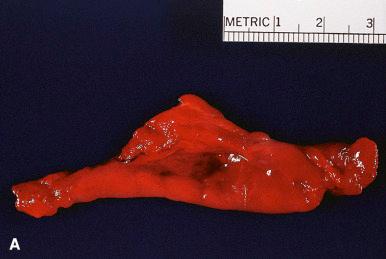
In mixed gonadal dysgenesis (usually characterized by a 45,X/46,XY mosaicism or 46,XY phenotype), one gonad is represented by a streak gonad or streak testis and a contralateral testis (that is typically cryptorchid) or bilateral streak testis. Individuals with this condition are particularly prone to the development of gonadoblastomas, a complication prevented by early removal of the gonads. The tumors may totally obliterate the testicular elements and thus lead to an incorrect typing of the dysgenesis.
True hermaphrodites may have ovotestes containing both ova and immature seminiferous tubules or other combinations of ovary and testis ( Fig. 35.2 ). The most common karyotypes are 46,XX (60%), 46,XY (12%), and mosaic (28%). Multiple tumors can occur in these gonads.
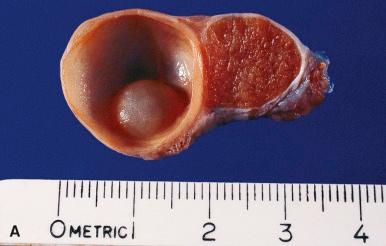
The familial syndrome of testicular feminization is the most common type of male pseudohermaphroditism. It occurs in individuals with a normal male chromosome constitution with an end-organ defect (androgen insensibility). It is characterized by the presence of several well-developed female secondary sex characteristics. These patients consult a gynecologist because of amenorrhea or sterility. They are found to have a vagina, no uterus, and bilateral cryptorchid testes. The latter often contain nodular masses of immature tubules that should not be confused with Sertoli–Leydig cell tumor ( Fig. 35.3 ). The syndrome is of further clinical importance because of the eventual occurrence of malignant tumors in the cryptorchid testes of approximately 9% of these patients. For this reason, the testes should be removed after puberty and supplemental estrogen therapy given. A classification of disorders of sexual development is presented in Table 35.1 .
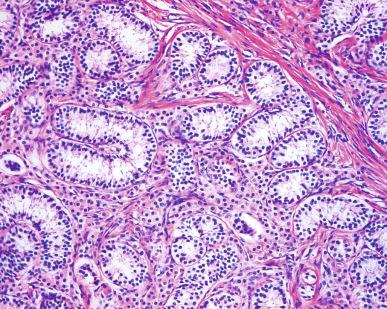
| SYNDROME | GONAD | DUCTS | EXTERNAL GENITALIA | PUBERTY | BARR | CHROMOSOMES | FSH | HORMONES 17-KS | ESTROGEN | REMARKS |
|---|---|---|---|---|---|---|---|---|---|---|
| Klinefelter | Testis with hyalinized sclerotic tubules and clumped Leydig cells | Male | Male | Normal penis with small testes; partial androgen lack | “True” are chromatin positive, a few are 2+ or 3+ | All chromatin positive have 2 Xs and a Y in at least some cells. Chromatin negative are 46,YY | ↑↑ | N or ↑ | N | Affects 1 : 400 newborn males |
| Turner | Streak gonad with whorled stroma | Female | Female | No pubertal development; rare cases show mild virilization | 50% chromatin negative | Second sex chromosome missing or abnormal in some or all of the cells | ↑↑ | ↓ | ↓ | 1 : 7000 newborns, more common in abortuses; short stature |
| True hermaphrodite | Ovary and testis | All have uterus, most have tubes too, a few have vasa | Ambiguous but 80% favor the male | 80% have gynecomastia, 50% menstruate | 80% chromatin positive | 60% are 46,XX in blood cells only; Y present in most of the others | N | N | N | — |
| Mixed gonadal dysgenesis | Streak plus testis or tumor | Female; vas found occasionally | Vary from female (often with clitoromegaly) to male with hypospadias to normal male | Virilization, sometimes complete; breast development only with tumors | Chromatin negative | Almost all are mosaics including XO stem; many have Y-bearing stem as well | ↑ | N | ? | — |
| Dysgenetic male pseudohermaphroditism | Dysgenetic testis | Mixed male and/or female | Variable virilized | Rarely patients may be fertile | Chromatin negative | Some are XO/XY | ↑ | N | ? | — |
| Familial male pseudohermaphroditism that ranges from testicular feminization to | Immature infertile testis | No uterus, ± rudimentary vas | Female with short, blind vagina | Breasts develop but sexual hair is missing | Chromatin negative | 46,XY | ↑ or N | ↑ or N | N | Sex-linked recessive or sex-limited autosomal dominant |
| Reifenstein syndrome | Infertile testis | Male | Male with hypospadias ± cleft scrotum | Androgen lack is evident in incomplete virilization | Chromatin negative | 46,XY | ↑ or N | ↑ or N | ? | |
| Female Pseudohermaphroditism | ||||||||||
| 1. Congenital adrenal hyperplasia | Ovary | Female | Variably virilized | Amenorrhea with virilization | Chromatin positive | 46,XX | N | ↑↑ | N | Autosomal recessive |
| 2. Nonadrenal | Ovary | Female | Variably virilized | Normal | Chromatin positive | 46,XX | N | N | N | Consider maternal exposure to progestins or androgens |
Ovarian diseases of surgical importance can be broadly divided into non-neoplastic cysts, inflammations, and neoplasms. Non-neoplastic cysts are sufficiently common as to be the norm during the reproductive years; cysts up to 6 cm, detected by ultrasound, can be followed and most will resolve spontaneously, reflecting their functional nature.
Inclusion cysts (“cortical inclusion cysts”) are common in older women; they are generally small and multiple and have no clinical significance. Most of them probably arise from invaginations of the surface epithelium, with subsequent loss of the connection with the surface ( Fig. 35.4A ). Microscopically, they are lined by a flattened, cuboidal, or columnar epithelium; tubal metaplasia is frequent (see Fig. 35.4B ). Psammoma bodies may be seen in their lumen or in the adjacent stroma. By definition cortical inclusion cysts are less than 1 cm and if larger they are considered to be serous cystadenomas, if there is tubal epithelium, or benign simple cysts if lined by nondescript flattened or cuboidal epithelium. This rule need not be firmly adhered to; in general, if a cyst is clinically evident it can be designated a cystadenoma or benign simple cyst, while a small cyst that is an incidental finding can be designated an inclusion cyst. This practice reflects the arbitrary nature of the definitions, with a continuum existing between inclusion cyst and serous cystadenoma.
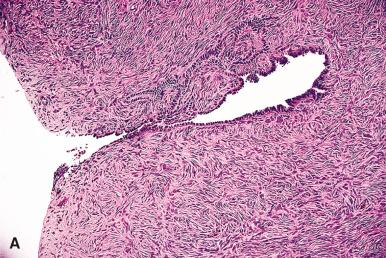
Follicular cysts form by distention of developing or atretic follicles and usually do not exceed 10 cm in diameter ( Fig. 35.5 ). It has been proposed that cystic follicular structures be designated as (normal) cystic follicles when measuring less than 2.5 cm and as follicular cysts when exceeding this diameter. The latter may occur at any age from infancy to menopause and are asymptomatic in the majority of cases. Occasionally, twisting of the pedicle occurs, with resulting hemorrhagic infarction of the ovary. In children, the cysts may be seen in conjunction with precocious puberty. During reproductive life, they may be associated with endometrial hyperplasia and metrorrhagia. The cyst fluid may contain estrogens.
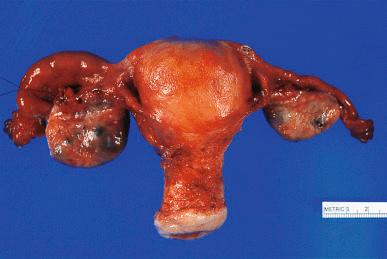
The cyst wall is lined by theca, with or without an inner granulosa layer ( Fig. 35.6 ). The theca layer is frequently luteinized. The granulosa layer may be luteinized after puberty but not before. Multiple luteinized follicular cysts (theca–lutein cysts; hyperreactio luteinalis) are common in cases of hydatidiform mole and choriocarcinoma but also have been seen in twin pregnancies and, exceptionally, in uncomplicated single pregnancies ( Fig. 35.7 ). Large solitary luteinized follicular cyst is a rare lesion presenting during pregnancy and puerperium, unaccompanied by endocrine abnormalities. The median diameter of this type of cyst is 25 cm. Marked focal atypia is often seen in the luteinized cells of this lesion.
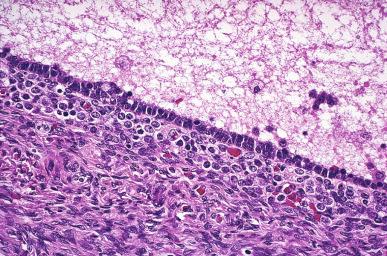
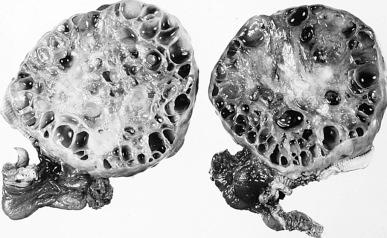
Polycystic (sclerocystic) ovaries are characterized by multiple follicular cysts or cystic follicles with varying degrees of luteinization of the theca interna, and dense fibrosis of the superficial cortex. Evidence of previous ovulation (i.e. corpora lutea or albicantia) is sparse or absent ( Fig. 35.8 ). Various clinical manifestations may develop in patients with polycystic ovaries, including amenorrhea and sterility, endometrial hyperplasia, and frank virilism; these fall under the collective designation of polycystic ovary syndrome (PCOS), formerly (and still occasionally) referred to as Stein–Leventhal syndrome. The pathogenesis of PCOS is poorly understood. These patients have “masculinizing” pituitary and ovarian responses to stimulation by the specific gonadotropin-releasing hormone agonist nafarelin, suggesting that the regulation of the ovarian 17-hydroxylase and C-17,20-lyase activities is abnormal. Dysregulation of 11β-hydroxysteroid dehydrogenase, causing increased oxidation of cortisol to cortisone, has also been documented.
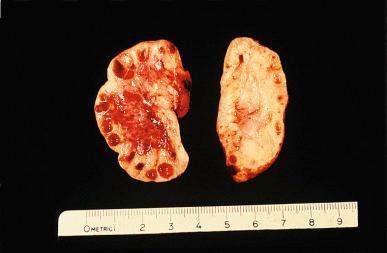
In general, the ovaries of patients with PCOS have the macroscopic and microscopic features of polycystic ovaries just described. The histologic appearance does not correlate well with clinical manifestations in a given patient, and sclerocystic changes can be seen as an incidental finding in asymptomatic patients whose ovaries are removed for unrelated reasons. Polycystic ovaries have also been observed in association with primary hypothyroidism.
Most patients with PCOS will respond favorably, with restoration of the menstrual cycle, to medical treatment, typically metformin (an oral hypoglycemic agent) and an aromatase inhibitor such as letrazole. The endometrium of patients with PCOS may become hyperplastic, and endometrial carcinoma may develop against this background, the tumor typically being well differentiated and superficial.
Stromal hyperplasia and hyperthecosis is characterized by a diffuse or nodular proliferation of plump ovarian cortical stromal cells encroaching on the medulla ( Fig. 35.9 ). Ovaries involved by stromal hyperplasia typically measure more than 5 cm in greatest dimension. Patchy luteinization of these cells may be present, a finding termed stromal hyperthecosis . Stromal hyperplasia and hyperthecosis may be associated with estrogenic or androgenic effects, obesity, hypertension, and an abnormal glucose tolerance test or even frank diabetes. The onset of symptoms may be abrupt, thus simulating a virilizing ovarian tumor. Immunohistochemical studies have shown androgen production by the luteinized stromal cells, suggesting that estrogenic effects in these cases are mediated through peripheral aromatization of these androgens.

The boundaries between polycystic disease and stromal hyperplasia are ill-defined ( Fig. 35.10 ) ; however, typical stromal hyperplasia lacks cysts and is usually more refractory to therapy.
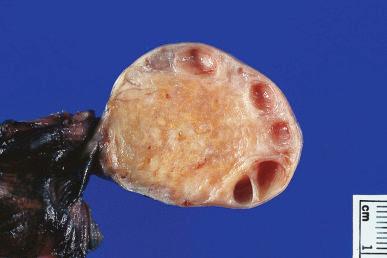
Corpus luteum cysts are single and usually less than 6 cm in diameter. They may develop at the end of the menstrual cycle or may occur in pregnancy ( Fig. 35.11 ). The cyst wall is composed of luteinized granulosa and theca cell layers. Hyaline bodies and foci of calcification may be found in the cysts associated with pregnancy. The fluid content is often bloody. If the cyst ruptures, hemorrhage into the peritoneal cavity occurs (sometimes over 500 mL), and an erroneous diagnosis of ruptured ectopic pregnancy may be made. It should be remembered that the corpus luteum is normally a cystic structure. The arbitrary diameter of 2.5 cm has been proposed to distinguish the (normal) cystic corpus luteum from a corpus luteum cyst , in a manner analogous to that employed for follicle-related cystic formations. Distinction between a corpus luteum cyst and a luteinized follicular cyst can be arbitrary; the former diagnosis is favored when the degree of luteinization is similar to that of the cells in a normal corpus luteum.
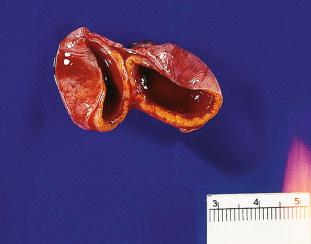
Ectopic decidual reaction can occur in the ovary during pregnancy and occasionally even in the absence of current or recent pregnancy.
So-called luteomas of pregnancy are yellow or orange solid nodules that may reach sizable proportions ( Fig. 35.12 ). They have been typically encountered during cesarean section in multiparous women, sometimes accompanied by a mild degree of virilization. If left undisturbed, they will regress after delivery. Microscopically, the lesions are composed of masses of uniform theca–lutein cells ( Fig. 35.13 ). Occasionally, there is an associated granulosa cell proliferation. All of the reported lesions have been benign. It is reasonable to regard them as nodular hyperplasias of theca–lutein cells rather than true neoplasms. If pregnancy luteoma is correctly identified by frozen section, no further surgery is necessary. A steroid cell tumor should not be diagnosed based on frozen section of an ovarian mass performed at the time of C-section as it is more likely to be a luteoma of pregnancy, and an incorrect diagnosis of steroid cell tumor may lead to an unnecessary oophorectomy. This scenario illustrates, as well as any example, the importance of having adequate clinical history at the time of intraoperative consultation/frozen section.
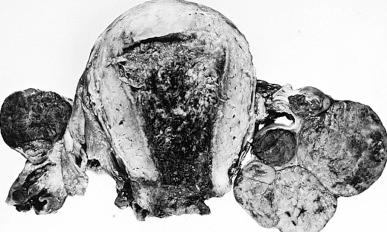
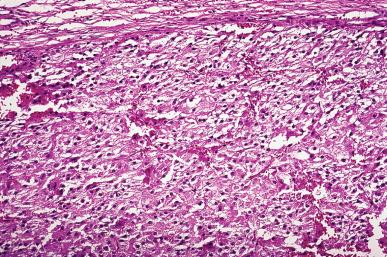
Developmental cysts derived from wolffian (mesonephric) and müllerian (paramesonephric) remnants are common in the region of the ovarian hilus. Suffice it to say here that, according to some authors, it is possible to distinguish these two types of tissue—and sometimes the cysts derived from them—on microscopic grounds. Wolffian structures are lined by cuboidal, predominantly nonciliated epithelium resting on a well-developed basement membrane; müllerian formations are lined by generally taller, ciliated and nonciliated epithelium with larger nuclei and resting on an inconspicuous basement membrane. Such a distinction is not clinically important and may not be possible in some cases, and the designation of “Benign parovarian (or paratubal) cyst” may be used. Both may have a smooth muscle coat. According to these criteria and some ultrastructural differences, hydatids of Morgagni (pedunculated cysts at the fimbriated end of the fallopian tube) are believed to be of müllerian origin, whereas most parovarian and paratubal cysts (in the tubo-ovarian ligament) and Gartner duct cysts (in the vaginal wall) are thought to arise from wolffian remnants.
Cysts of the rete ovarii are characterized by a hilar position, an epithelial lining of variable height that is usually nonciliated, crevices along the inner surfaces, and a fibromuscular wall that often contains hyperplastic hilus cells. The rete ovarii may also be the site of benign proliferative lesions that have been variously reported as adenomatous hyperplasia and adenoma ( Fig. 35.14 ).
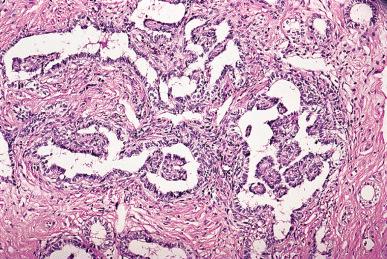
Epidermoid cysts , lined by benign squamous epithelium without evidence of skin adnexal structures or other teratomatous elements, are exceptionally rare and are of uncertain histogenesis.
Squamous metaplasia of the OSE accompanied by subjacent fibrosis has been described in patients on long-term peritoneal dialysis.
Amyloidosis can exceptionally present in the form of bilateral ovarian masses.
Supernumerary ovaries are extremely rare. Most of the reported cases have measured less than 1 cm. They should be distinguished from accessory ovaries , which are small portions of ovarian tissue situated near—and sometimes connected to—the normally placed organ.
Nonspecific inflammation of the ovary usually spreads from the endometrium and is practically always associated with tubal involvement. A large, loculated cystic mass filled with pus or secretion is often the result, the ovarian stroma forming part of the cystic wall (tubo-ovarian abscess or cyst). Exceptionally, a solid mass rich in foamy macrophages develops in long-standing cases (“xanthogranulomatous oophoritis”).
Granulomatous infections such as tuberculosis occur in the ovary. Invariably this is hematogenous in origin and often also involves the tube and endometrium. In time, the infection may subside and leave a large tubo-ovarian cystic mass. Other infectious agents responsible for granulomatous oophoritis are Actinomyces (particularly common after the introduction of intrauterine devices), Schistosoma , and Enterobius vermicularis . Rarely, sarcoidosis and Crohn disease involve the ovary, the latter as a result of direct extension from the bowel. Foreign body granulomas can occur in the ovarian surface secondarily to talc, cornstarch, carbon pigment (at the site of fulguration surgery), other foreign materials, and keratin; the latter may originate from a ruptured ovarian cystic teratoma or may have spilled through the fallopian tube from an endometrial adenocarcinoma of endometrioid type, with squamous differentiation. Palisading granulomas of unknown etiology have also been reported, most of them in patients with a history of previous pelvic surgery.
Autoimmune oophoritis is a poorly understood cause of premature ovarian failure characterized microscopically by lymphocytic and plasma cell infiltration in relation to developing follicles but not primordial follicles ( Fig. 35.15 ). It results in primary ovarian failure with either primary or secondary amenorrhea. Many of the reported cases have been associated with adrenal failure (Addison disease), hypothyroidism, or both conditions.

Eosinophilic perifolliculitis is characterized by a predominantly eosinophilic infiltrate around the follicles; it is not clear how this rare disorder relates to autoimmune oophoritis.
Giant cell arteritis occasionally involves the ovary of elderly women; it may occur as an isolated finding (most frequently) or as a component of generalized giant cell arteritis.
The ovary is the most common site of endometriosis, as defined by the presence of endometrial glands and stroma outside the uterus. The pathogenesis of endometriosis remains incompletely understood; suffice it to say that endometriosis shows evidence of clonality and in a minority of cases the epithelium has an activating KRAS mutation. Ovarian endometriosis is usually associated with infertility, and it remains active during the childbearing years. Pain associated with the menstrual cycle is the most common symptom; infrequently, the disease is complicated by massive ascites or perforation into the peritoneal cavity. Grossly, it usually presents as small, slightly raised, blueberry-like spots on the ovarian surface, often accompanied by fibrous adhesions. In cases with extensive involvement, the entire ovary may be converted into a “chocolate cyst” as a result of repeated hemorrhages ( Fig. 35.16 ). Microscopically, the typical lesions are composed of endometrial glands, endometrial stroma, and fresh and old (hemosiderin-containing) hemorrhagic foci ( Fig. 35.17 ). The endometrial stroma is responsible for the bleeding; it has cells with a “naked nucleus” surrounded by reticulin and typical spiral arterioles, in conjunction with old and recent hemorrhage. Unfortunately, this diagnostic combination of findings is not always present. The more advanced the endometriotic lesion, the more difficult the diagnosis and the greater the number of sections required to make it. Not infrequently, the repeated hemorrhages have totally destroyed the endometrial tissue, the cyst being lined by several layers of hemosiderin-laden macrophages with a thick fibrous wall. Under these circumstances, the most the pathologist can do is to report the case as a hemorrhagic cyst and comment that the changes are “consistent” with those of endometriosis. Sometimes, the lesion is entirely composed of necrotic pseudoxanthomatous nodules , to be distinguished from infectious granulomas and necrotic neoplasms ( Fig. 35.18 ). Other morphologic variations of endometriosis include the formation of Liesegang rings, stromal elastosis, and smooth muscle hyperplasia, the latter sometimes resulting in the formation of uterus-like masses.
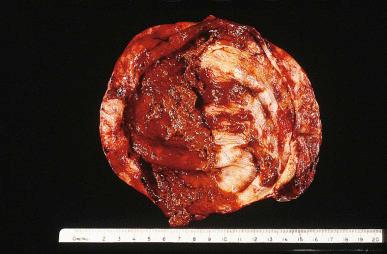
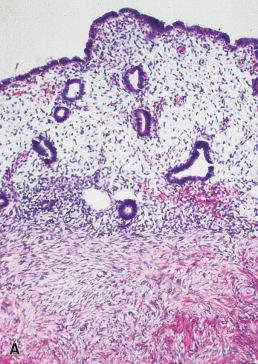
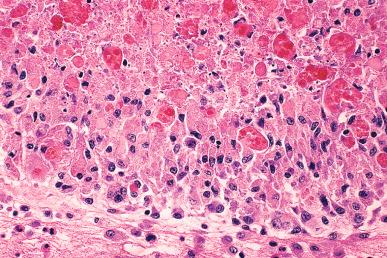
The ectopic endometrial tissue of endometriosis is subject to most of the influences that affect the intrauterine endometrium. Ovarian endometriosis more often undergoes malignant transformation than endometriotic foci elsewhere in the pelvis. Somewhat confusingly, two different premalignant changes have been described within ovarian endometriosis, and both have been termed “atypical endometriosis.” The first consists of cells that do not show significant stratification but which have prominent nuclear atypia ( Fig. 35.19 ). These cells are thought to be a precursor of clear cell carcinoma and can have ARID1A mutations and show an immunophenotype intermediate between endometriosis and clear cell carcinoma. The other premalignant change seen in ovarian endometriosis is morphologically identical to atypical endometrial hyperplasia, with glandular crowding and atypia. This is thought to be the precursor of endometrioid carcinoma. Although clear cell and endometrioid carcinomas account for most malignancies arising in endometriosis, a wide range of other malignancies may also be encountered in association with ovarian endometriosis (e.g. carcinosarcoma, adenosarcoma, endometrial stromal sarcoma, seromucinous borderline tumor, and, rarely, serous borderline tumor or low-grade serous carcinoma).
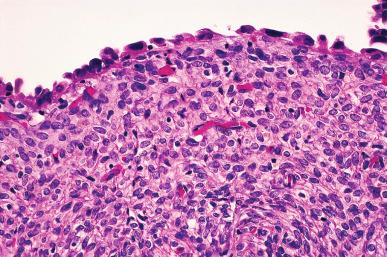
The classification of ovarian tumors is primarily morphologic and based on the cytologic features of the tumor cells. This approach has served us well over the years, with recent molecular studies, for the most part, supporting this morphology-based classification system and demonstrating that it accurately reflects both histogenesis/cell of origin, and the underlying molecular abnormalities of the different ovarian tumor subtypes. While there have been some minor adjustments made, reflected in the 2014 WHO classification system, the fundamental premise that the ovary contains four major types of tissue, all of which can give rise to a variety of neoplasms, has remained unchanged for decades. These four tissue types are:
Epithelium
Germ cells
Sex cords
Ovarian stroma, specialized and nonspecific.
Epithelial tumors, numerically the most important group of neoplasms, have traditionally been thought to derive from the OSE and were thus referred to as “surface epithelial” tumors. It is now appreciated that the epithelial tumors of the ovary are of diverse origins, histogenetically, and the cell of origin of each histotype will be discussed in the section devoted to that specific histotype, later in this chapter.
Epithelial ovarian tumors are subclassified based on cell type as serous, endometrioid, clear cell, mucinous, seromucinous, or transitional (Brenner) . It is now appreciated that the histotype reflects differences in cell of origin and molecular abnormalities, and subclassification based on cell type, or histotype, has taken on increased importance in recent years.
Within each histotype, tumors are further subclassified as benign, borderline, or malignant. Benign tumors are characterized by epithelium with benign nuclear features and differentiated cytoplasm; for example, the benign serous tumors feature cells with cilia, morphologically identical to the normal ciliated cells of the fallopian tube. Benign epithelial tumors can be further subclassified based on whether they are predominantly cystic, cystic and solid, or predominantly solid with fibromatous stroma, as cystadenoma, cystadenofibroma, and adenofibroma, respectively. There is an arbitrary cutoff between cystadenoma and cystadenofibroma, with the latter having at least 25% solid component. This subclassification based on the gross appearance of the tumor is not clinically relevant, beyond allowing correlation with radiologic findings.
The borderline category is characterized by cytologic atypia, but without evidence of invasion, and its existence as a diagnostic entity has been controversial. Although it has been stated that this category is unique to ovarian tumors, other “borderline” tumors do exist, such as low-grade mucinous neoplasm of the vermiform appendix. Attempts have been made to eliminate the borderline category of ovarian epithelial tumors, so that tumors are classified as either benign or malignant ; however, the borderline category has survived these attempts. The key to the survival of “borderline” as a diagnostic entity can probably be found in its history as a subcategory of ovarian epithelial tumors ; it was recognized that there were advanced-stage tumors that did not behave like usual high-stage ovarian carcinoma, and in these patients adjuvant treatment did more harm than good. Creation of a borderline designation for these unusual tumors allowed for a more conservative management to emerge. This is true specifically for serous and seromucinous borderline tumors, where a significant minority of cases (15%–40%) are associated with extra-ovarian implants (i.e. stage II or III), and yet there is a favorable prognosis. Although the borderline category has been extended to the other ovarian histotypes (e.g. clear cell, endometrioid), such tumors are invariably stage I and can be expected to behave in a benign fashion when diagnosed using strict criteria.
The distinction between borderline and malignant is based on the presence of “invasion” in the latter; the criteria for invasion differ from histotype to histotype, and histotype-specific discussions are provided later in this chapter. The malignant epithelial tumors (“carcinomas”) show other striking differences between histotypes, which are summarized in Table 35.2 , and described in more detail in the histotype-specific sections of this chapter, later. It is important to recognize that although histotype of ovarian carcinoma was considered to not be diagnostically reproducible or clinically relevant in the past, that has changed, and ovarian carcinoma histotype can be diagnosed with very high interobserver agreement and increasing clinical significance. There remain 1%–2% of ovarian carcinomas that show unusual morphologic features and defy histotype assignment, but in most tumors the diagnosis of histotype is straightforward on routine H&E stains. The importance of histotype in ovarian carcinoma can be illustrated by consideration of two aspects of ovarian carcinoma: stage at presentation and association with hereditary cancer susceptibility syndromes.
| HGSC | CCC | EC | LGSC | MC | |
|---|---|---|---|---|---|
| Mean age | 63 | 55 | 58 | 53 | 45 |
| 5-Year survival (stage III only) | 40 | 23 | 66 | 71 | NA |
| Origin | Fallopian tube | Endometriosis | Endometriosis | Cystadenoma | Germ cell, transitional epithelium |
| Molecular abnormalities | Genomic instability; TP53 mutation; homologous recombination DNA damage repair defects; CCNE1, NOTCH3 activation; Rb, NF1 inactivation | Wnt-catenin activation; ARID1A-chromatin remodeling complex inactivation; PI3K activation; PTEN inactivation, MMR abnormalities | KRAS/BRAF/MEK pathway activation | ERBB2/KRAS/BRAF/MEK pathway activation | |
| Inherited syndromes | HBOC | LS | LS | ?LS | ?LS |
| Sensitivity to platinum-based chemotherapy | Sensitive | Relatively resistant | Relatively resistant | Relatively resistant | Relatively resistant |
| Adjuvant/targeted therapies licensed or in trial | PARPi; immune checkpoint inhibitors | Radiotherapy; Sunitinib | mTOR inhibitors | Selumetinib (MEK1/2 inhibitors) | Trastuzumab |
The stage at presentation of ovarian carcinoma of different histotypes are shown in in Table 35.3 . For patients presenting with high-stage disease (i.e. stage III or IV), the large majority are high-grade serous, while patients presenting with tumors confined to the adnexa are more likely to have a tumor other than high-grade serous carcinoma (HGSC), which account for a minority of such cases. The histotype of organ confined ovarian carcinomas, e.g. presenting at the time of frozen section for an adnexal mass that was thought to be an endometriotic cyst preoperatively, are very different than those diagnosed in patients with ascites and omental involvement.
| OVARIAN CARCINOMA HISTOTYPE | PERCENTAGE (ALL STAGES) (%) | PERCENTAGE (STAGE III/IV) (%) | STAGE I/II: STAGE III/IV |
|---|---|---|---|
| High-grade serous | 68.1 | 87.7 | 20:80 |
| Clear cell | 12.2 | 4.5 | 82:18 |
| Endometrioid | 11.3 | 2.5 | 88:12 |
| Mucinous | 3.4 | 1.2 | 82:18 |
| Low-grade serous | 3.4 | 5.3 | 18:82 |
There are two common autosomal dominant hereditary cancer syndromes: hereditary breast and ovarian cancer syndrome (HBOCS) and Lynch syndrome, with the former first described by Henry Lynch and the latter named after him for his pioneering work in establishing the importance of these hereditary cancer syndromes; both are associated with an increased risk of ovarian carcinoma, but the histotypes of the carcinomas encountered in these syndromes are completely different. Germline mutations in BRCA1 or BRCA2, which encode proteins involved in high-fidelity repair of double-strand (DS) DNA breaks, account for 95% of cases of HBOCS, and these patients have an estimated 45% lifetime risk of developing ovarian carcinoma, although the risk varies depending on the specific mutation, being higher in patients with BRCA1 mutations than those with BRCA2 mutations. In HBOCS, patients are at increased risk of developing HGSC but not at significantly increased risk of developing other histotypes of ovarian carcinoma, borderline tumors, germ cell tumors or sex cord–stromal tumors. Of patients newly diagnosed with HGSC, 15%–20% will have a germline BRCA1 or BRCA2 mutation; consideration should therefore be given to genetic counseling and testing for HBOC in all such patients.
Lynch syndrome, secondary to mutations in genes involved in another DNA repair pathway that is, mismatch repair, is associated with an 8%–10% lifetime risk of developing ovarian carcinoma, and the carcinomas that arise in patients with Lynch syndrome are of those histotypes associated with endometriosis (i.e. endometrioid and clear cell). The likelihood of a clear cell or endometrioid carcinoma of the ovary being associated with Lynch syndrome appears to be the same as that of colorectal carcinoma or endometrial carcinoma (i.e. 3%–5%). Therefore, if screening for Lynch syndrome mutations through immunostaining for mismatch repair enzymes in newly diagnosed carcinomas is being done, it has been suggested that it should be inclusive of not just colorectal and endometrial carcinoma, but the 20% of ovarian carcinomas of endometrioid or clear cell type.
Serous tumors make up about one-fourth of all ovarian tumors and most occur in adults. A critical advance in our understanding of ovarian neoplasia is the recent recognition that low-grade serous neoplasms are a different disease than HGSC. In the past it was thought that HGSCs arose through progression of low-grade serous neoplasms, but it is now recognized that, despite the shared “serous” or fallopian tube cell type, the low-grade and high-grade serous tumors are not closely related. Differences include cell and site of origin, molecular events during pathogenesis and response to chemotherapy, among others. Accordingly the low-grade and high-grade serous tumors will be discussed separately.
This category is inclusive of benign and borderline serous tumors and low-grade serous carcinoma. Grossly, these tumors typically consist of cystic masses, usually unilocular, containing a clear but sometimes viscous fluid ( Fig. 35.20 ). Papillary formations are often present, most of them protruding into the cavity but some occasionally occur on the outer surface ( Fig. 35.21 ). In serous borderline tumors the papillae lining cysts are more delicate than the predominantly stromal papillae of benign serous tumors ( Fig. 35.22 ). The low-grade serous carcinomas tend to be solid but lack conspicuous areas of necrosis and hemorrhage.
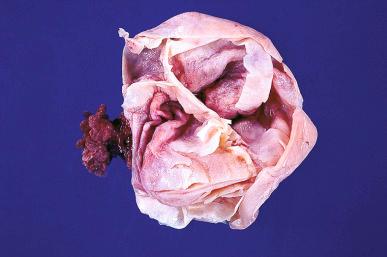
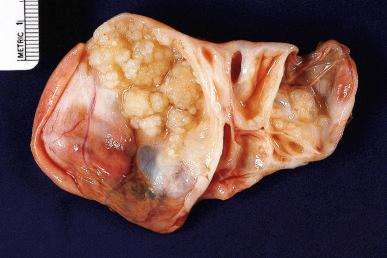
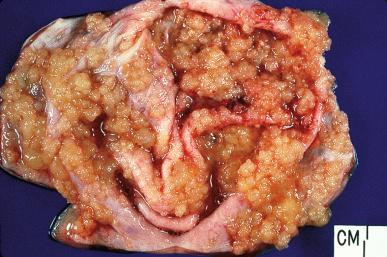
Microscopically, cuboidal to columnar cells are seen lining the wall of the cysts and the papillae ( Fig. 35.23 ). They are similar to normal tubal epithelium at both a light and electron microscopic level. Hobnail cells can be present, not to be taken as evidence of the presence of a clear cell carcinoma component. In borderline tumors and low-grade serous carcinomas, calcific concretions with concentric laminations (psammoma bodies) are often present.
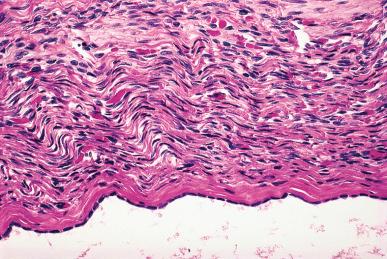
A morphologic spectrum of proliferation exists in these tumors. At one end is the benign serous cystadenoma , in which the cysts and the papillae (if present) are lined by a single layer of cells, without atypia, architectural complexity, or invasion (see Fig. 35.23 ). At the other end is low-grade serous carcinoma, characterized by low-grade nuclear atypia, mitotic activity, stratification, glandular complexity, branching papillary fronds, and stromal invasion ( Fig. 35.24 ). Stromal invasion in low-grade serous carcinoma can show a number of patterns, which may be admixed in a single tumor, and include: A. single cells and small, compact, irregular nests of cells, B. micropapillae and complex papillary forms (see Fig. 35.24A ), C. inverted macropapillae, in which the neoplastic epithelium covers broad fibrovascular stromal stalks (this is the least common pattern; see Fig. 35.24B ), D. cribriform, E, glandular or cystic, and F. solid sheets with slit-like spaces. In all of these patterns there is typically a clear space surrounding the neoplastic cells. Serous psammocarcinoma , so called, is a rare variant of low-grade serous carcinoma characterized by massive psammoma body formation ( Fig. 35.25 ). In between these two ends of the spectrum are serous borderline tumors, characterized by cellular stratification, detached cell clusters, atypia and occasional mitotic figures, but lacking stromal invasion ( Fig. 35.26 ). Borderline tumors account for approximately 15% of all serous tumors. Ciliated cells are invariably present in benign serous tumors, less common in serous borderline tumors and uncommon in low-grade serous carcinoma.
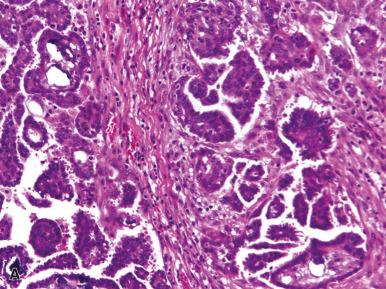
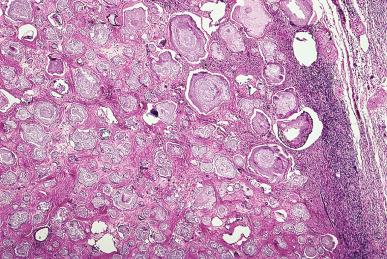

In summary, benign serous tumors (serous cystadenoma, serous cystadenofibroma, or serous adenofibroma) are distinguished from serous borderline tumor by the absence of cellular stratification and atypia. The finding of detached clusters of epithelial cells is important evidence of cellular stratification; epithelial pseudostratification with apparent multilayered epithelium can be seen due to tangential sectioning, but this never leads to the presence of detached cell clusters. When the “borderline” features are present only focally (i.e. account for less than 10% of the cyst lining) in an otherwise benign tumor, the designation “cystadenomas with focal proliferation or focal atypia” can be used and these tumors also have a benign course .
Borderline serous tumors are distinguished from low-grade serous carcinoma by the absence of stromal invasion. It should also be noted that microinvasion in serous borderline tumors, defined as one or more invasive foci measuring less than 5 mm in greatest dimension, is a relatively common finding in serous borderline tumor, seen in 10%–15% of cases, and is not of prognostic significance ( Fig. 35.27 ). The microinvasive foci typically appear as individual cells or clusters of cells with abundant eosinophilic cytoplasm (“eosinophilic metaplastic cells”) that show a low Ki67 labeling index. It should be noted that in 50% or more of low-grade serous carcinomas there is a coexisting borderline component, from which the low-grade serous carcinoma has presumably arisen. A special circumstance is when there is a serous borderline tumor of the ovary and invasive low-grade serous carcinoma in the extra-ovarian implants (a situation that in the past would have led to a diagnosis of “serous borderline tumor with invasive implants). Recognition of invasive carcinoma in extra-ovarian implants is based on the criteria proposed by Bell et al. : the presence of a haphazard infiltrative growth pattern that destroys the architecture of the invaded tissues. Surface peritoneal involvement does NOT constitute evidence of invasion in extra-ovarian implants; there must be invasion into underlying tissue. The presence of invasion at extra-ovarian sites should lead to a diagnosis of low-grade serous carcinoma, even if the ovarian tumor is entirely borderline.
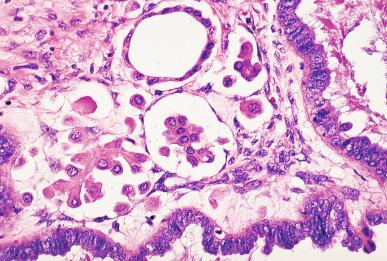
Low-grade serous carcinomas are distinguished from the much more common HGSCs by their frequent association with serous borderline tumor and a lesser degree of nuclear pleomorphism (less than threefold variation in nuclear size). In cases where there remains difficulty in deciding between these two possibilities, the low-grade serous carcinomas have a much lower mitotic rate than HGSCs (12 or fewer MF per 10 HPF), and p53 immunostaining shows a normal pattern, compared to the abnormal staining (so-called all or nothing patterns) present in 95% of HGSCs.
The benign serous tumors are invariably benign, while the prognosis of serous borderline tumors is dependent primarily on stage. Stage Ia tumors, without surface involvement, positive washings or extra-ovarian implants, are associated with an excellent prognosis. Curiously the presence of nodal involvement is not associated with an adverse outcome in patients with serous borderline tumor. Micropapillary architecture is associated with a worse prognosis in patients with serous borderline tumor, but it is not established whether this is independent of the well-known association of micropapillarity with higher stage and a component of invasive low-grade serous carcinoma (either within the ovary or at extra-ovarian sites). Micropapillary architecture is defined as nonhierarchical branching of elongate filiform papillae and/or a cribriform architecture, with the latter being considerably less common than the former. The papillae should be at least 5 times as long as wide ( Fig. 35.28 ), and the micropapillary focus must be confluent for at least 5 mm. Kurman and colleagues have suggested that serous borderline tumor with micropapillary features should be diagnosed as noninvasive low-grade serous carcinoma; micropapillarity in a stage Ia tumor is not associated with a different prognosis than in a stage Ia conventional serous borderline tumor, and it is therefore not justified, in our opinion, to introduce a new diagnostic term for these patients (i.e. noninvasive low-grade serous carcinoma), especially when the diagnostic criteria have not been shown to be highly reproducible. The borderline category was introduced in the 1950s to clearly indicate that there is a different natural history for patients with these tumors, compared to those with usual carcinoma, and this rationale is still applicable and constitutes an argument against use of the terminology of “noninvasive low-grade serous carcinoma.” As noted previously, micropapillary architecture is more likely to be associated with either higher stage disease (ovarian surface involvement or extra-ovarian implants), or the presence of invasive low-grade serous carcinoma, and recurrence as carcinoma is also more common in these tumors, so when micropapillarity is present it should be documented in the pathology report and a careful search for evidence of higher stage or invasion is warranted, but that is the only action we would currently recommend based on the presence of micropapillary variant of serous borderline tumor.
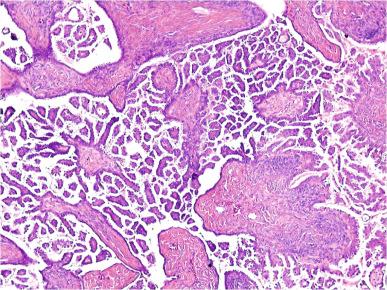
The prognosis of low-grade serous carcinoma is highly dependent on stage. For stage Ia disease the prognosis is excellent, but in most reported cases there is extra-ovarian spread at the time of diagnosis and these patients have a poor prognosis, similar to that of patients with HGSC. With recurrence and tumor progression, low-grade serous carcinomas can become higher grade, with increased mitotic activity. These tumors differ from usual HGSC in lacking TP53 mutations (i.e. they are not examples of “progression” from low-grade serous carcinoma to HGSC of the usual type).
Immunohistochemically, the typical keratin profile of low-grade serous tumors is CK7+/CK20–. They also express CK8, 18, and 19, EMA, B72.3, vimentin, glial fibrillary acidic protein (GFAP) (occasionally), the β-subunit of human chorionic gonadotropin (hCG) (in a minority of cases), and receptors for estrogen and progesterone. A small minority (around 10%) of serous tumors stain for calretinin and/or inhibin, a potentially confusing finding in the differential diagnosis with sex cord–stromal tumors. WT1 and PAX8 stain most low-grade ovarian serous tumors. Serous borderline tumors and low-grade serous carcinoma have relatively few mutations and are typically diploid. The most common mutations are in KRAS and BRAF .
Most HGSCs show bilateral ovarian involvement. Tubal fimbrial involvement is often noted on gross examination and is usually unilateral. On sectioning the ovarian masses are solid and cystic, with conspicuous hemorrhage and necrosis. Microscopically, HGSC is characterized by morphologic heterogeneity, and there is often an admixture of different architectural patterns including papillary, micropapillary, slit-like, glandular, microcystic/ microglandular, solid, and transitional-like patterns. While papillary elements and slit-like spaces are characteristic of HGSC ( Figs. 35.29 and 35.30 ), well-formed rounded glands are also common, resulting in a pseudoendometrioid appearance ( Fig. 35.31 ). The tumor cells usually have scant to moderate amounts of cytoplasm, but occasionally there is abundant eosinophilic or clear cytoplasm, or cells with vacuoles and intracytoplasmic mucin, resulting in a signet ring appearance. The neoplastic cells consistently show high-grade nuclear features, with significant pleomorphism and a high mitotic rate with frequent abnormal mitotic figures. As a rule, high-power microscopic fields with multiple mitoses are easily found, and individual bizarre tumor giant cells are also often present, features that are helpful in ruling out low-grade serous carcinoma. Areas of necrosis are common, but psammoma bodies are less frequently encountered than in low-grade serous carcinoma.
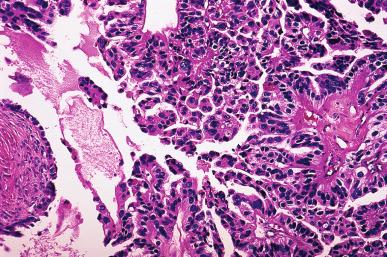
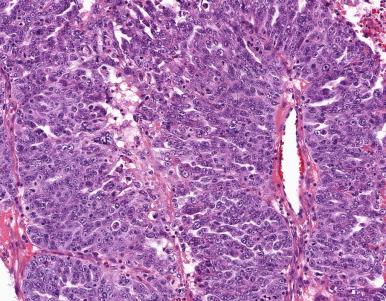
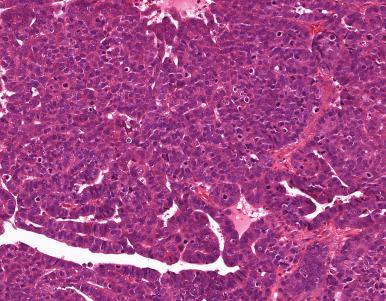
When there is a general discussion of “ovarian carcinoma” it is usually concerned with HGSC, as it accounts for 70% of all cases (see Table 35.2 ) and a disproportionate number of the deaths due to disease. The latter is attributable to these tumors being high-stage at diagnosis, which is itself attributable to most of them originating in the tubal fimbria (discussed later). There has unfortunately been little progress in treatment of HGSC. Although most patients experience a remission, recurrence and death due to progressive disease are usual. Treatments targeting the molecular abnormalities of HGSC, such as PARP inhibitors, show great promise, but they have not yet entered practice as adjuvant treatment, where they would be given with curative intent. Nonetheless, the activity they show against recurrent HGSC is impressive and they will undoubtedly become more widely used over the coming years.
There is now irrefutable evidence that most extrauterine HGSCs arise from the fallopian tube (most commonly the fimbrial end) from a precursor lesion referred to as serous tubal intraepithelial carcinoma (STIC). It was first recognized that the fimbrial end of the fallopian tube is the site of origin of a large majority of HGSCs in patients with a germline BRCA1 or BRCA2 mutations, based on the fimbrial location of early carcinomas identified in risk-reducing salpingo-oophorectomy specimens. This observation became possible only with more detailed and systematic examination of the fallopian tubes; introduction of the S ectioning and E xtensively E xamining the FIM bria (SEE-FIM) protocol resulted in a dramatic increase in the number of STICs and small invasive HGSCs detected. It is now clear that STIC and small tubal mucosal HGSCs are found in sporadic “ovarian” HGSCs at comparable frequency to what is seen in high-risk patients with HBOCS. Adding to the cases with STIC those where the fimbrial end of the tube is overgrown and incorporated into an adnexal mass, one is left with fewer than 20% of HGSCs where there is not tubal involvement. It is also clear that the tubal lesions usually precede the disease in the ovaries and other extratubal sites. Four recent studies have reported on HGSC diagnosed as an incidental finding at surgery carried out for unrelated reasons; these occurred in women who were not at high risk for ovarian cancer. The tubal mucosa was involved in 100% (48 of 48) of cases and STIC, with or without an invasive mucosal carcinoma, was identified in 98% (47 of 48).
It should be remembered that fallopian tube mucosal involvement and ovarian involvement by uterine or nongynecological primary tumors can occur and can mimic STIC. Most cases with both endometrial serous carcinoma (either intraepithelial or invasive) and concomitant unilateral or bilateral HGSC in the ovary (and/or STIC or HGSC in the fallopian tube) represent adnexal metastases from an endometrial primary. WT1 may be of value in these cases, as most tubal HGSCs exhibit diffuse nuclear positivity with WT1, while most uterine serous carcinomas are negative. Unfortunately, there is some overlap in that a proportion of uterine serous carcinomas are WT1 positive (the percentage has varied between studies, but may be up to 30%) and a small percentage of tubal HGSCs are WT1 negative.
While the assignment of primary site in HGSC does not change management, it is often a requirement for tumor registries, and a uniform approach to site assignment is desirable. The following guidelines take into account recent advances in our understanding of the histogenesis of HGSC, described previously : A. Primary site should be assigned as tubal in the presence of STIC or invasive mucosal HGSC in either fallopian tube, or when either tube is partly or fully incorporated into and inseparable from a tubo-ovarian mass. B. Primary site should be assigned as ovarian only when there is ovarian involvement and the fallopian tubes are clearly visible, have been dissected away from the surface of the ovaries, fully examined by a standardized SEE-FIM protocol and neither STIC nor invasive mucosal carcinoma is present in either tube. C. Primary site should be assigned as peritoneal only when both tubes and both ovaries are grossly and microscopically normal; primary peritoneal HGSC should only be diagnosed in a specimen from primary surgery (as neoadjuvant chemotherapy can impact on the ability to assign primary site by changing the disease distribution) and only after complete examination of both tubes and both ovaries using a standard protocol.
The differential diagnosis between HGSC and low-grade serous carcinoma was discussed in the preceding section. The differential diagnosis also includes endometrioid carcinoma, clear cell carcinoma, and undifferentiated carcinoma ( Fig. 35.32 ). As endometrioid-like glandular formation, clear cell change or solid undifferentiated architecture are rarely present throughout a well-sampled tumor, the presence of typical HGSC will establish the diagnosis. In problematic cases (e.g. a small biopsy with limited tissue available to seek different architectural patterns), immunostaining may help ( Table 35.4 ). For a diagnosis of undifferentiated carcinoma, it should be undifferentiated throughout; by definition, even a minor component showing differentiation excludes a diagnosis of undifferentiated carcinoma. Similarly, one should resist the urge to diagnose mixed HGSC and endometrioid carcinoma, or HGSC and clear cell carcinoma. True admixtures of these components are rare, and most purported examples are, based on clinical and immunohistochemical features, HGSC with glandular architecture, or clear cells, respectively.
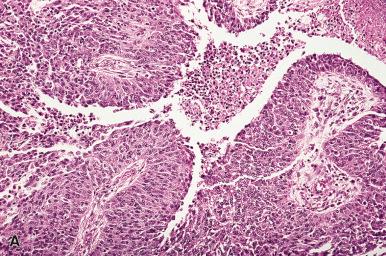
| HGSC | LGSC | ENDOMETRIOID | CLEAR CELL | MUCINOUS | |
|---|---|---|---|---|---|
| WT1 | Diffuse positive | Diffuse positive | Negative | Negative | Negative |
| p53 | Mutation type | Wild type | Wild type or mutation type | Wild type | Wild type or mutation type |
| p16 | Diffuse positive | Focal positive | Focal positive | Variable | Variable |
| ER | Diffuse or focal positive or negative | Diffuse positive | Diffuse positive | Negative | Negative or focal positive |
| HNF-1β | Negative | Negative | Negative | Diffuse or focal positive | Variable |
| Napsin A | Negative | Negative | Negative | Diffuse or focal positive | Negative |
Become a Clinical Tree membership for Full access and enjoy Unlimited articles
If you are a member. Log in here